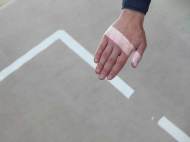Virtual protective barriers could increase safety around industrial robots
 Automated helpers in industry today are usually enclosed by protective barriers. Industrial safety regulations permit contact between people and robots only under certain conditions, since the risk of injury to humans is too great. In order to allow safer collaboration, researchers at Fraunhofer-Gesellschaf are developing a projection and camera-based system able to prevent potential collisions between robots and humans working together.
Automated helpers in industry today are usually enclosed by protective barriers. Industrial safety regulations permit contact between people and robots only under certain conditions, since the risk of injury to humans is too great. In order to allow safer collaboration, researchers at Fraunhofer-Gesellschaf are developing a projection and camera-based system able to prevent potential collisions between robots and humans working together.
The safety system employs conventional projectors and cameras, which are normally mounted on the ceiling. One distinctive feature of the system is its projection of monitored safe zones directly onto a floor or wall. Projected beams produce visible lines in the work area, enabling humans to recognize the safe zone right away and know how close they may get to a robot. The monitoring system operates with modulated light, which provides the advantage over present camera-based space monitoring systems because it is reliable even under the effects of external light source.
When the camera detects any intrusion in the safe zone by an individual (the projected lines are disrupted), the robot acts according to the way it is programmed to in such situations. The robot decelerates or stops its operation, and the system allows additional optical and acoustic warning signals to be generated.
“Since we employ common standard components, our system can be installed cost effectively. The projector and camera are calibrated and synchronized to one another”, said Dr. Norbert Elkmann, Robotic Systems Business Unit Manager at the Fraunhofer IFF.
When a larger area needs to be monitored, the system can be extended as desired by additional projectors and cameras. Another distinctive feature is the ability to create a variety of positions and sizes of marked areas and the capability to give them any shape – for instance, a circle, a rectangle or any free form.
In addition, the experts can combine this system with robot controls and thus dynamically modify danger and safe zones. If, for example, a robot only works to the left of its workspace at times, the maximum robot workspace would not have to be monitored.
The potential applications of the projection and camera-based system are not merely limited to safe human-robot interaction. Other spaces in which safety is relevant, e.g. public buildings, can be monitored. The system can also be used wherever safe zones ought not to be perceptible – by projecting light which is not visible by a naked eye.









Leave your response!